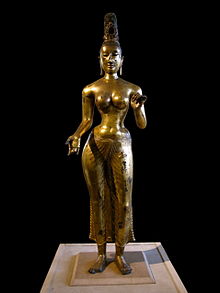

The Varadamudra (Sanskrit: वरदमुद्रा, romanized: varadamudrā) or Abheeshta Mudra is a mudra, a symbolic gesture featured in the iconography of Indian religions. It indicates a gesture by the hand and symbolises dispensing of boons.[1] It is represented by the palm held outward, with the fingers outstretched and pointing downwards. Sometimes, the thumb and the index finger meet, forming a circle.[2]
The Varadamudra and the Abhayamudra are the most common of several other mudras seen on divine figures in the art of Indian religions.[citation needed]
- ^ Bautze, Joachim Karl (1994). Iconography of Religions. BRILL. p. 15. ISBN 978-90-04-09924-1.
- ^ Jr, Robert E. Buswell; Jr, Donald S. Lopez (24 November 2013). The Princeton Dictionary of Buddhism. Princeton University Press. p. 960. ISBN 978-1-4008-4805-8.